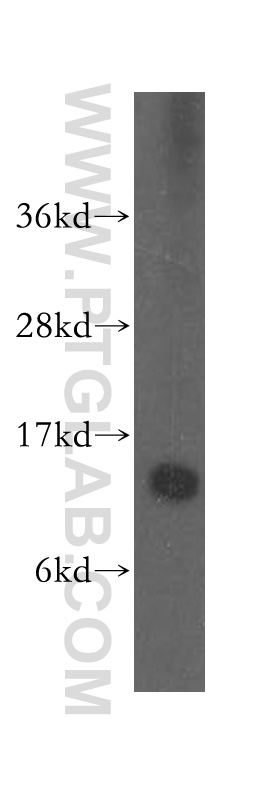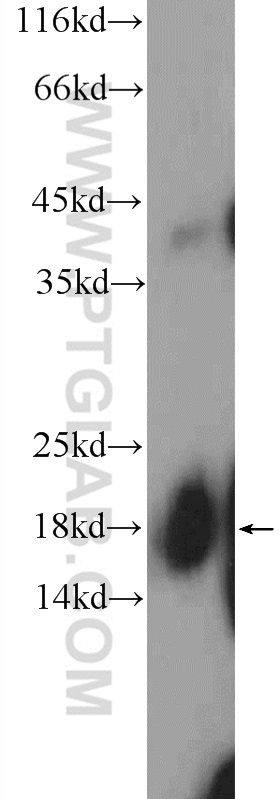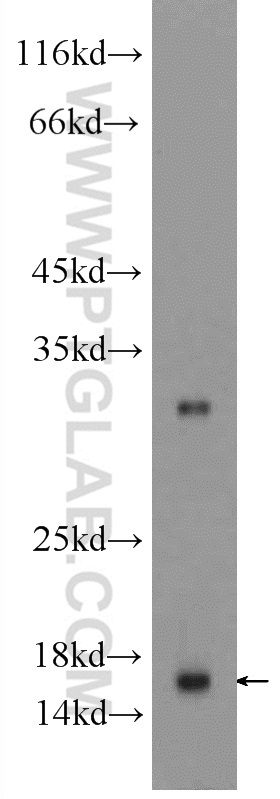验证数据展示
经过测试的应用
| Positive WB detected in | HEK-293 cells, HL-60 cells |
推荐稀释比
| 应用 | 推荐稀释比 |
|---|---|
| Western Blot (WB) | WB : 1:500-1:1000 |
| It is recommended that this reagent should be titrated in each testing system to obtain optimal results. | |
| Sample-dependent, Check data in validation data gallery. | |
发表文章中的应用
| WB | See 4 publications below |
| IHC | See 1 publications below |
产品信息
10352-1-AP targets SNRPD1 in WB, IHC, ELISA applications and shows reactivity with human samples.
| 经测试应用 | WB, ELISA Application Description |
| 文献引用应用 | WB, IHC |
| 经测试反应性 | human |
| 文献引用反应性 | human, mouse |
| 免疫原 | SNRPD1 fusion protein Ag0364 种属同源性预测 |
| 宿主/亚型 | Rabbit / IgG |
| 抗体类别 | Polyclonal |
| 产品类型 | Antibody |
| 全称 | small nuclear ribonucleoprotein D1 polypeptide 16kDa |
| 别名 | HsT2456, Sm D autoantigen, Sm D1, SMD1, snRNP core protein D1, SNRPD, SNRPD1 |
| 计算分子量 | 16 kDa |
| 观测分子量 | 13 kDa |
| GenBank蛋白编号 | BC001721 |
| 基因名称 | SNRPD1 |
| Gene ID (NCBI) | 6632 |
| RRID | AB_2193875 |
| 偶联类型 | Unconjugated |
| 形式 | Liquid |
| 纯化方式 | Antigen affinity purification |
| UNIPROT ID | P62314 |
| 储存缓冲液 | PBS with 0.02% sodium azide and 50% glycerol , pH 7.3 |
| 储存条件 | Store at -20°C. Stable for one year after shipment. Aliquoting is unnecessary for -20oC storage. |
背景介绍
Systemic lupus erythematosus is characterized by antibodies to a variety of intracellular self-antigens, such as dsDNA and Sm, and these serve as hallmarks in the diagnosis of systemic autoimmune diseases. SNRPD1 is one Sm components of the small nuclear ribonucleoprotein complexes(snRNPs). It's a charged protein scaffold to promote snRNP assembly or strengthen snRNP-snRNP interactions through nonspecific electrostatic contacts with RNA. This antibody detectes 13-16 kDa (SMD1) and 30 kDa (SMD1/SMD2 dimer form; PMID:15525645).
实验方案
| Product Specific Protocols | |
|---|---|
| WB protocol for SNRPD1 antibody 10352-1-AP | Download protocol |
| Standard Protocols | |
|---|---|
| Click here to view our Standard Protocols |
发表文章
| Species | Application | Title |
|---|---|---|
Cell Chem Biol Novel RNA-Affinity Proteogenomics Dissects Tumor Heterogeneity for Revealing Personalized Markers in Precision Prognosis of Cancer. | ||
Pharmacol Res Second-generation antipsychotics induce cardiotoxicity by disrupting spliceosome signaling: Implications from proteomic and transcriptomic analyses. | ||
Neuron Inhibition of RNA splicing triggers CHMP7 nuclear entry, impacting TDP-43 function and leading to the onset of ALS cellular phenotypes |


